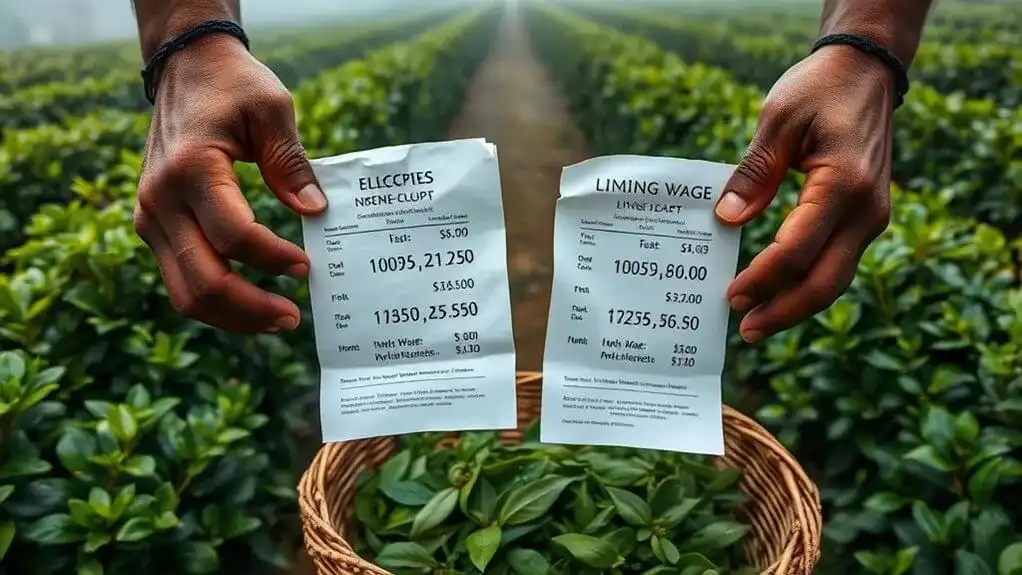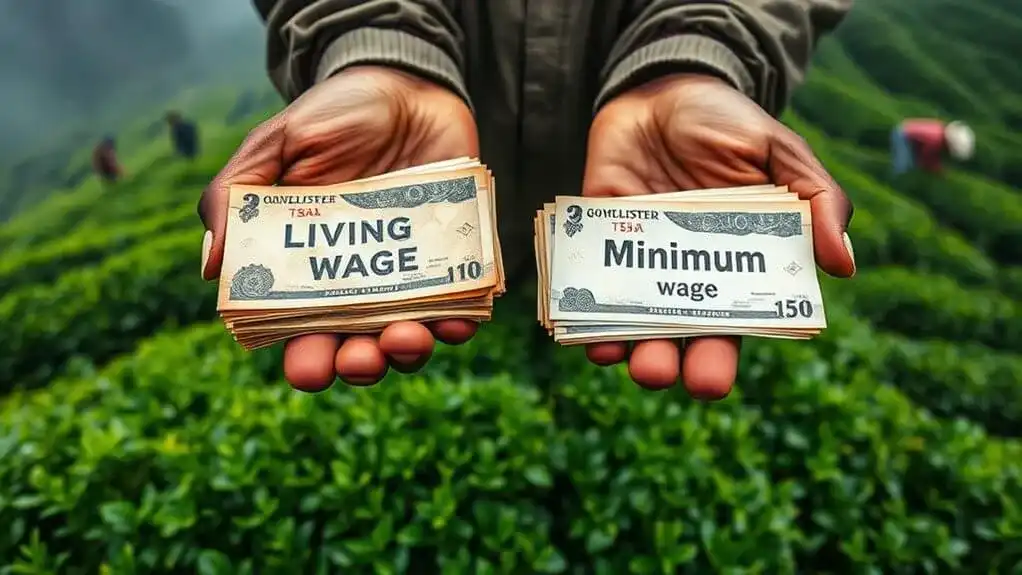The reality of tea worker compensation reveals a devastating gap between living and minimum wages. While the average American living wage is $27.53 per hour, tea workers in regions like Bangladesh earn just $1.43 per day – one-fifth of what's needed for basic survival. Women face even greater hardships, earning 50% less than men while enduring workplace abuse. Complex supply chains and weak collective bargaining perpetuate this crisis, but emerging solutions offer hope for transformative change.
Key Points
- Tea workers globally earn far below living wage standards, with workers in Assam receiving only one-fifth of what's needed for basic needs.
- While the U.S. living wage averages $27.53/hour, tea workers in Bangladesh earn just $1.43/day, highlighting extreme wage inequality.
- Women tea workers face double discrimination, earning roughly 50% less than male counterparts while experiencing workplace abuse and harassment.
- Complex supply chains and declining global tea prices create barriers to implementing living wages across tea-producing regions.
- Current minimum wages in tea-producing countries fail to meet living wage requirements, despite international guidelines defining fair pay as human right.
Understanding the Living Wage Concept

The concept of a living wage extends far beyond the basic notion of compensation, representing the minimum income necessary for workers to maintain a decent standard of living. Unlike minimum wage regulations, it's designed to guarantee workers can meet their basic needs without relying on government assistance or additional income sources.
A living wage takes into account essential expenses including food, housing, utilities, transportation, healthcare, and childcare. It's particularly distinct because it factors in supporting a family, not just individual survival. While many employers resist implementation due to increased labor costs, this approach remains crucial for worker well-being. The average American living wage of $27.53 per hour demonstrates how far current minimum wages fall short of meeting basic needs. The calculation typically involves using specialized calculators that consider local cost variations and divide annual household expenses into hourly wages based on a 40-hour workweek. Many employers provide in-kind compensation to help offset living wage requirements. Regular adjustments are vital to reflect changes in living costs, making sure workers maintain their purchasing power and quality of life over time.
The Gap Between Minimum and Living Wages

While understanding the living wage concept sets the foundation, examining its stark contrast with minimum wage reveals a troubling economic reality. The gap between these two wage levels continues to widen, driven by stagnant minimum wages and rising living costs. This disparity particularly affects the tea industry, where minimum wages often serve as the default payment rather than a baseline. The federal minimum wage has remained at $7.25 per hour since 2009. Basic necessities have experienced near historic increases in recent years, making survival even more challenging for minimum wage workers.
Wage disparities have created severe economic inequality, with over 44% of full-time U.S. workers unable to earn a living wage. The situation is especially dire in states following the federal minimum wage, like Georgia and Utah. Even states like Hawaii face significant challenges with a living wage gap exceeding $10 per hour. Factors such as inflation, informal labor practices, and ineffective collective bargaining contribute to this growing divide. The impact is most severe on women and people of color, highlighting the urgent need for systematic wage reform across industries.
Tea Industry's Wage Crisis

Deep within the global tea industry, a pervasive wage crisis threatens millions of workers' livelihoods, driven by systemic challenges that span the entire supply chain. The stark wage disparity is particularly evident in regions like Assam, where workers earn just one-fifth of a living wage, while women face additional discrimination through gender pay gaps and workplace abuse. The stark difference between these wages and the UK's £12.00 living wage highlights the severity of global wage inequality in the tea sector.
Multiple factors perpetuate this crisis: low tea prices squeeze profit margins, high production costs strain employers, and poor purchasing practices maintain power imbalances. Sri Lankan tea workers have witnessed a gradual increase from Rs450 minimum wage to Rs1,000 per day over the past decade. The lack of effective labor rights protection, particularly in collective bargaining, leaves workers vulnerable to exploitation. While certification schemes attempt to address these issues, industry resistance to wage increases remains strong, with plantation managers citing concerns about economic sustainability and global competitiveness. This complex web of challenges continues to obstruct meaningful progress toward fair compensation.
Human Rights Impact of Low Wages

Beyond mere economic hardship, low wages in the tea industry create devastating human rights violations that trap workers in cycles of poverty and exploitation. Workers face severe indebtedness to plantation owners, forcing them into conditions resembling bonded labor. The impact extends deeply into gender-based wage disparities, with women earning nearly half of men's wages while enduring sexual abuse and discrimination. In fact, this gender inequality reflects the broader issue where women globally receive 20% less pay than men. Major tea companies like Unilever and Ekaterra have failed to adequately address these compensation issues despite multiple reports of violations.
These human rights violations cascade through generations, as families resort to child labor to meet production quotas. Children often drop out of school to work in domestic services, construction, and unregulated factories. The crisis is further compounded by hazardous working conditions, exposure to pesticides, and dilapidated housing with poor sanitation. Without access to safe drinking water and medical care, workers' health continues to deteriorate, perpetuating the cycle of poverty. The transfer of benefits to government control has failed to improve workers' access to essential services and support systems.
Supply Chain Complexities and Worker Pay

The complex tea supply chain creates significant barriers to implementing living wages for workers. Tea producers struggle with labor-intensive costs and declining global prices, making it difficult to increase wages while maintaining profitability. Without supply chain transparency, power imbalances persist, keeping prices low and limiting workers' earning potential. Global tea production exceeds market demand, further driving down prices and wages. Many producers face financial constraints that limit their ability to raise worker compensation above minimum wage levels. A comprehensive project by Oxfam and ETP investigated wage conditions specifically for tea pluckers in key producing regions.
Recent initiatives are addressing these challenges through innovative approaches. Organizations like IDH have launched programs with major tea brands to bridge the living wage gap through data-driven calculations and ring-fenced funds. These efforts prioritize labor rights and guarantee fair compensation reaches workers directly. However, the prevalence of informal labor and weak collective bargaining continue to hinder progress. Long-term solutions require sustainable production costs, improved supply chain efficiency, and commitment from all stakeholders to support better wages.
Women Tea Workers: Disproportionate Effects

While women constitute over half of the tea industry's workforce, they face severe discrimination through lower wages, casual employment status, and limited job security. Gender equity remains elusive as women earn 10-20% less than men for identical work, while being systematically excluded from higher-paying roles. The lack of effective labor rights protection has left approximately 700,000 women tea workers in India struggling with poverty and isolation. Women are frequently required to perform physically demanding tasks like hoeing, weeding, pruning, and carrying loads over 40 kg throughout their lives. The widespread practice of placing men in control of women's wages further reinforces economic inequality within households. During the COVID-19 pandemic, women endured severe job losses, accounting for 61.9% of all positions eliminated.
Key challenges women tea workers face:
- Limited access to healthcare, pensions, and social protections due to casual worker status
- Noticeably lower participation in trade unions and decision-making roles
- Intersectional discrimination based on gender, caste, and class
- Inadequate collective bargaining power to improve working conditions
- Poor enforcement of statutory rights regarding leave and housing standards
Economic Ripple Effects of Poor Compensation

Living below subsistence-level wages has created devastating ripple effects throughout tea-producing regions, particularly in Bangladesh where 97% of workers face extreme poverty. With daily wages of just Tk170, Bangladesh's tea workers earn less than half of what their counterparts make in Sri Lanka (Tk674) and Assam (Tk330), highlighting stark economic disparities in the industry.
These wage inequities ripple beyond individual workers, affecting entire communities and the industry itself. Child labor persists in tea estates as families struggle to survive on meager wages. Research shows that up to 35 million workers could benefit from minimum wage increases in similar low-wage industries. Women face unique hardships as they make up a significant workforce in the tea sector while enduring poor conditions. While the global tea trade generates $3.75 billion, the lack of wage equity threatens its sustainability. Smallholder farmers are considering abandoning tea production, and the demand for premium tea is declining. Without collective action from governments, businesses, and unions to establish living wages, the industry risks further destabilization, compromising both worker well-being and economic viability.
Global Standards and Local Realities

Despite international guidelines defining living wages as a fundamental human right, stark disparities persist between global standards and local realities in tea-producing regions. The gap between minimum wages and living wages remains particularly severe, with workers in Bangladesh earning just $1.43 per day while their counterparts in Sri Lanka receive considerably more.
The disconnect between global standards and local realities manifests in several critical ways:
- Female workers face a 50% gender pay gap and widespread sexual abuse
- National minimum wages fall far below living wage requirements
- Informal labor practices circumvent wage protections
- Certification schemes fail to address poverty-level wages
- Supply chain transparency remains inadequate
These disparities highlight the urgent need to bridge the gap between international guidelines and on-the-ground implementation, ensuring tea workers receive compensation that enables a dignified standard of living. The European Union's double decency threshold requirement could serve as a model for establishing more equitable wage standards in tea-producing regions.
Breaking the Cycle: Pathways to Fair Pay

As tea industry stakeholders seek sustainable solutions to wage inequality, several promising mechanisms have emerged to bridge the gap between minimum and living wages. The Jointly Agreed Living Wage Differential, established by IDH and major tea companies, guarantees transparent contributions reach workers through base wages and benefits. Meanwhile, Fairtrade's premium system provides essential financial support, allowing workers to invest in health, education, and housing improvements.
Worker empowerment through collective bargaining rights plays a significant role in achieving fair pay. Organizations like ETP promote supply chain efficiency and digital wage payments while supporting workers' rights to negotiate better compensation. These initiatives, combined with human rights due diligence and improved transparency, are creating pathways for sustainable wage improvements across the tea industry, though challenges with informal labor practices persist.
Conclusion
Tea workers' struggle for fair compensation isn't just about numbers on a paycheck – it's about dignity, sustainability, and justice. While minimum wages keep workers surviving, living wages keep communities thriving. The industry must bridge this gap by embracing transparency, enforcing standards, and prioritizing human rights. Only then can tea workers move from barely existing to truly living, from systematic exploitation to sustainable empowerment.

